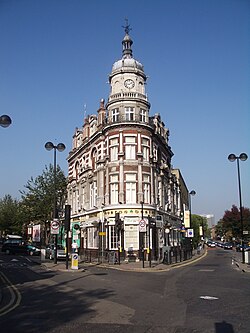Tufnell Park
| Tufnell Park | |
| Middlesex | |
|---|---|
 The Boston Arms, Tufnell Park | |
| Location | |
| Grid reference: | TQ295855 |
| Location: | 51°33’25"N, 0°8’2"W |
| Data | |
| Post town: | London |
| Postcode: | N7, N19, NW5 |
| Dialling code: | 020 |
| Local Government | |
| Council: | Camden / Islington |
| Parliamentary constituency: |
Islington North / Holborn & St Pancras |
Tufnell Park is an area of heavily urbanised Middlesex, almost indistinguishable between Gospel Oak to the west and Holloway to the east, with Camden Town to the south. Its name belies its nature, for there is little green space here.
History
Origins
Tufnell Park Road runs along the line of an old Roman road which stretches from the Roman camp beneath Barclays Bank and Batten's Carpets on the Holloway Road, up Dartmouth Hill and over Hampstead Heath.[1] For centuries the area was renowned for its dairy farms which kept London and the south supplied with milk.
The area kept a rural air well into the 19th century in its important role as a base for a number of dairies supplying the capital. In 1753 the area became the property of William Tufnell who was granted the manor of Barnsbury by his father-in-law Sir William Halton. The manor (now demolished) stood on the site of the Holloway Odeon. The manor's gateposts can still be seen, however, towards the west end of Tufnell Park Road. Tufnell petitioned the Parliament for permission to develop his estate but the leases he was granted were left unused. William's father was Samuel Tufnell of Langleys in Essex. William also inherited Nun Monkton in Yorkshire and estates in Northumberland from his great-uncle, Nathaniel Payler. He also inherited Pleshy from his godfather William Joliffe. These estates went to his older brother John Jolliffe Tufnell of Langleys.
The Tufnell Park estate passed to John's his brother George Foster Tufnell, Member of Parliament for Beverley, then to his son William Tufnell (d 1809), Member for Colchester, who married in 1804 into a fortune owned by Mary Carleton (daughter of Thomas Carleton of South Carleton d.1829).
The manor then passed to Henry Tufnell (d 1854), who sevred as Member of Parliament for Ipswich and for Devonport, as Liberal chief whip, and as a Lord of the Treasury, then to Henry Archibald Tufnell (d 1898) who died with no children, and then to Lt Col Edward Tufnell (d 1909) HM Inspector of Schools, Factory Commissioner, Director Greenwich Hospital.
Development


Serious building began in 1845 with a scheme sponsored by Henry Tufnell and designed by John Shaw Jr, who had laid out the Eton Estate in Chalk Farm. This initial work was largely limited to the area around Carleton Road. In 1865 the scheme was taken up by George Truefitt who developed most of the local villas and St. George's Church (1865), built for Anglican secessionists. The housing stock was of a solid nature, and Tufnell Park kept its good name until the end of the century. Charles Booth in his survey of London Life and Labour reported that the older streets (Anson Road and Carleton Road) housed a mixture of retired merchants and music hall artistes who were rich enough to holiday abroad over winter. He believed that second wave of building threatened to create a metropolis "from which the rich would soon be going". The private girls' school established at the corner of Carleton and Brecknock Roads was closed in 1878 after many of its pupils drowned in the SS Princess Alice disaster.
Tufnell Park was more fortunate than several of its neighbours. Whereas roads and railway lines were sliced through Kentish Town and Camden in the 19th century, they mostly passed through Tufnell Park in tunnels, and Junction Road railway station provided a direct link with central London.
In popular culture
The shabby genteel reputation of Tufnell Park made it a standard comic reference in the nineteenth and twentieth centuries. George and Weedon Grossmith locate their aspirational Mr Pooter in Tufnell Park (Upper Holloway) in Diary of a Nobody. Julian and Sandy, the camp characters in the Round the Horne radio series, frequently referenced Tufnell Park.
Transport
Tufnell Park tube station is on the Northern Line.
The nearest London Overground stations are Upper Holloway and Gospel Oak
References
- ↑ A History of the County of Middlesex - Volume pp 29-37: {{{2}}} (Victoria County History) – 'Islington: Growth: Holloway and Tollington'